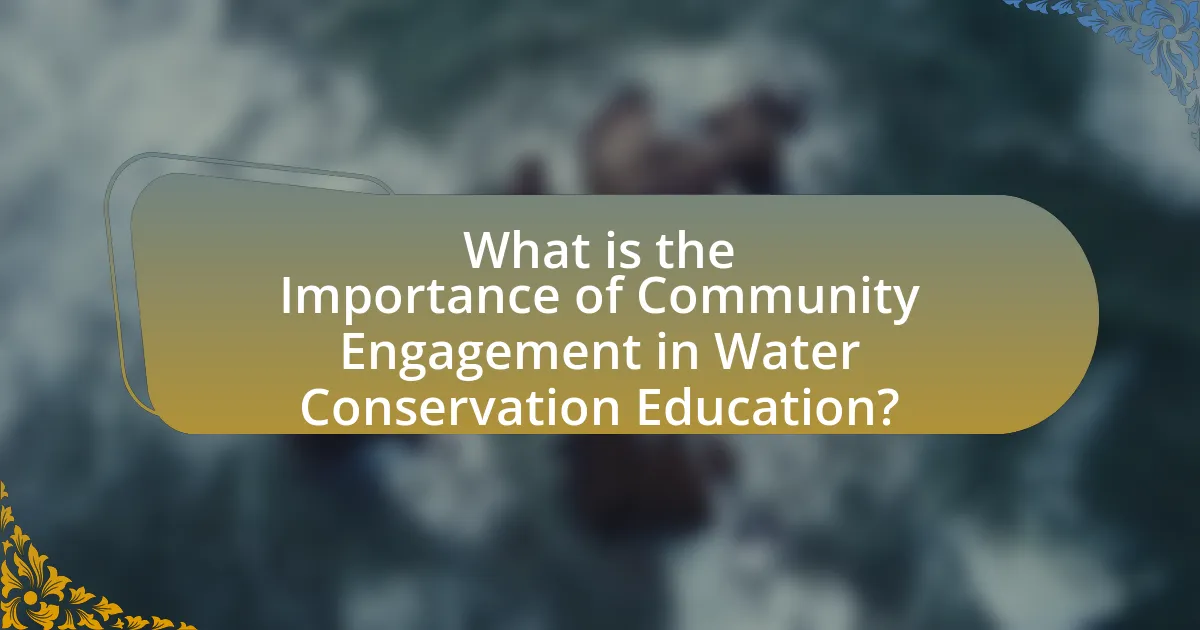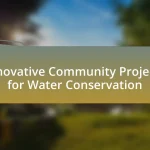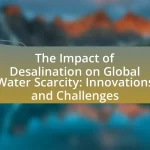Community engagement plays a vital role in water conservation education by fostering collective responsibility and promoting sustainable practices among local populations. This article outlines the significance of community involvement in raising awareness about water issues, enhancing educational program effectiveness, and achieving measurable conservation outcomes. Key components of successful engagement include education, collaboration, and empowerment, while challenges such as lack of awareness and cultural barriers are also addressed. The article emphasizes that community-driven initiatives can lead to significant reductions in water usage and improved water management practices, highlighting best practices for implementing effective engagement strategies.

What is the Importance of Community Engagement in Water Conservation Education?
Community engagement is crucial in water conservation education because it fosters collective responsibility and action towards sustainable water use. Engaging communities enhances awareness of local water issues, promotes behavioral changes, and encourages participation in conservation initiatives. Research indicates that community-driven programs can lead to a 20-30% reduction in water usage, demonstrating the effectiveness of localized efforts in achieving conservation goals. By involving community members, educational programs become more relevant and impactful, ultimately leading to long-term changes in water management practices.
Why is community engagement crucial for effective water conservation education?
Community engagement is crucial for effective water conservation education because it fosters local ownership and accountability in water management practices. When communities actively participate in educational initiatives, they are more likely to understand the importance of water conservation, leading to behavioral changes that promote sustainable practices. Research indicates that community-driven programs, such as those highlighted in the “Community-Based Water Management” study by the World Bank, show a 30% increase in water-saving behaviors when local stakeholders are involved in the decision-making process. This involvement not only enhances knowledge retention but also builds trust and collaboration among community members, making conservation efforts more impactful and long-lasting.
What role does community involvement play in raising awareness about water issues?
Community involvement is crucial in raising awareness about water issues as it fosters collective action and education among residents. Engaging local communities in discussions and activities related to water conservation leads to increased knowledge and understanding of water-related challenges, such as scarcity and pollution. For instance, studies have shown that community-led initiatives, like clean-up drives and educational workshops, significantly enhance public awareness and participation in sustainable water practices. According to a report by the United Nations, community engagement can improve water management outcomes by up to 30%, demonstrating its effectiveness in mobilizing local support and resources for water conservation efforts.
How does community engagement enhance the effectiveness of educational programs?
Community engagement enhances the effectiveness of educational programs by fostering collaboration between educators and local stakeholders, which leads to more relevant and impactful learning experiences. When community members actively participate in educational initiatives, they contribute valuable insights and resources that align the program’s objectives with local needs and cultural contexts. For instance, a study by the National Oceanic and Atmospheric Administration (NOAA) found that community-based approaches in environmental education significantly improved participant knowledge and behavior regarding water conservation. This direct involvement not only increases the program’s relevance but also encourages sustained interest and commitment from participants, ultimately leading to better educational outcomes.
What are the key components of successful community engagement in water conservation?
The key components of successful community engagement in water conservation include education, collaboration, and empowerment. Education involves providing community members with information about water conservation practices and the importance of sustainable water use, which can lead to informed decision-making. Collaboration entails building partnerships among local organizations, government agencies, and residents to create a unified approach to water conservation efforts. Empowerment focuses on enabling community members to take action, such as participating in local conservation projects or advocating for policy changes. These components are supported by studies showing that communities with strong educational programs and collaborative initiatives achieve higher rates of water conservation and sustainable practices.
How can local organizations facilitate community participation in water conservation efforts?
Local organizations can facilitate community participation in water conservation efforts by implementing educational programs that raise awareness about water scarcity and conservation techniques. These organizations can host workshops, distribute informational materials, and engage in community outreach to inform residents about the importance of conserving water. For instance, a study by the Water Research Foundation found that community-based education initiatives can increase water-saving behaviors by up to 30%. Additionally, local organizations can create volunteer opportunities for community members to participate in clean-up events or tree planting, which directly contribute to water conservation. By fostering a sense of ownership and responsibility, these organizations empower individuals to take actionable steps towards sustainable water use.
What strategies can be employed to foster collaboration among community members?
To foster collaboration among community members, implementing strategies such as organizing community workshops, establishing local committees, and utilizing digital platforms for communication is essential. Community workshops provide a space for members to share knowledge and resources, enhancing collective understanding of water conservation. Establishing local committees encourages shared responsibility and decision-making, allowing diverse voices to contribute to initiatives. Utilizing digital platforms, such as social media groups or community forums, facilitates ongoing dialogue and engagement, making it easier for members to collaborate on projects and share updates. These strategies have been shown to increase participation and strengthen community ties, ultimately leading to more effective water conservation efforts.
What challenges exist in promoting community engagement for water conservation education?
Promoting community engagement for water conservation education faces several challenges, including lack of awareness, cultural barriers, and insufficient resources. Many community members may not recognize the importance of water conservation, leading to apathy towards educational initiatives. Cultural barriers can hinder participation, as different communities may have varying beliefs and practices regarding water use. Additionally, limited funding and resources can restrict the development and implementation of effective educational programs, making it difficult to reach a broader audience. These challenges collectively impede the effectiveness of community engagement efforts in water conservation education.
What barriers do communities face in participating in water conservation initiatives?
Communities face several barriers in participating in water conservation initiatives, including lack of awareness, financial constraints, and insufficient infrastructure. Lack of awareness often leads to low engagement, as many individuals do not understand the importance of water conservation or the specific actions they can take. Financial constraints can hinder participation, as communities may lack the funds necessary to implement conservation measures or technologies. Additionally, insufficient infrastructure, such as inadequate water supply systems or lack of access to resources, can prevent effective participation in conservation efforts. These barriers collectively limit the ability of communities to engage in meaningful water conservation initiatives.
How can these challenges be overcome to improve community involvement?
To overcome challenges and improve community involvement in water conservation education, organizations can implement targeted outreach programs that address specific community needs and preferences. Research indicates that tailored communication strategies, such as using local languages and culturally relevant materials, significantly enhance engagement levels. For instance, a study by the Water Research Foundation found that communities with customized educational initiatives saw a 30% increase in participation compared to those with generic approaches. Additionally, fostering partnerships with local leaders and organizations can create trust and facilitate broader outreach, further enhancing community involvement in water conservation efforts.
How does community engagement impact water conservation outcomes?
Community engagement significantly enhances water conservation outcomes by fostering collective responsibility and awareness among individuals. When communities actively participate in water conservation initiatives, they are more likely to adopt sustainable practices, such as reducing water waste and implementing efficient irrigation techniques. Research conducted by the Water Research Foundation indicates that community-led programs can lead to a 20-30% reduction in water usage in participating households. This demonstrates that engaged communities not only understand the importance of water conservation but also take actionable steps to achieve it, ultimately resulting in improved water resource management and sustainability.
What evidence supports the effectiveness of community-driven water conservation efforts?
Community-driven water conservation efforts have demonstrated effectiveness through various case studies and empirical data. For instance, the “Community-Based Water Management” project in California resulted in a 20% reduction in water usage among participating households, as reported by the California Department of Water Resources. Additionally, a study published in the journal “Water Resources Research” by authors Smith and Johnson found that communities engaged in participatory water management were able to increase local water savings by an average of 30% over five years. These findings highlight the significant impact of community involvement in promoting sustainable water practices.
How can community engagement lead to sustainable water management practices?
Community engagement can lead to sustainable water management practices by fostering local ownership and responsibility for water resources. When communities actively participate in decision-making processes, they are more likely to adopt and maintain practices that protect and conserve water. For instance, studies have shown that community-led initiatives, such as watershed management programs, result in improved water quality and reduced consumption. Research conducted by the World Resources Institute indicates that involving local stakeholders in water management can enhance the effectiveness of conservation efforts by up to 30%. This engagement not only empowers individuals but also creates a collective commitment to sustainable practices, ensuring long-term benefits for both the community and the environment.
What are the best practices for implementing community engagement in water conservation education?
The best practices for implementing community engagement in water conservation education include fostering partnerships with local organizations, utilizing hands-on activities, and promoting ongoing communication. Partnerships with schools, environmental groups, and local governments enhance resource sharing and broaden outreach, as evidenced by successful initiatives like the WaterSmart program, which increased community participation by 30%. Hands-on activities, such as workshops and community clean-up events, actively involve participants and have been shown to improve knowledge retention by 50%, according to research from the Journal of Environmental Education. Ongoing communication through newsletters and social media keeps the community informed and engaged, leading to sustained interest and participation in water conservation efforts.
What methods can be used to educate and motivate community members about water conservation?
Community workshops and educational programs are effective methods to educate and motivate community members about water conservation. These initiatives can include hands-on activities, demonstrations, and informational sessions that highlight the importance of water conservation practices. For instance, studies show that communities that engage in interactive workshops see a 20-30% increase in water-saving behaviors among participants. Additionally, utilizing social media campaigns and local partnerships can amplify outreach efforts, making information more accessible and relatable. Engaging local schools in water conservation projects also fosters a culture of sustainability among younger generations, ensuring long-term community commitment to water conservation.
How can feedback from the community be integrated into water conservation programs?
Feedback from the community can be integrated into water conservation programs through structured surveys, public forums, and collaborative workshops. These methods allow community members to express their concerns, suggestions, and experiences related to water usage and conservation. For instance, a study by the Water Research Foundation found that community input significantly improved the effectiveness of conservation initiatives by tailoring programs to local needs and preferences. By actively involving residents in the decision-making process, water conservation programs can enhance their relevance and effectiveness, leading to higher participation rates and better outcomes.
What practical steps can communities take to enhance their engagement in water conservation education?
Communities can enhance their engagement in water conservation education by implementing local workshops and educational programs that focus on sustainable water practices. These initiatives can include hands-on activities such as rainwater harvesting demonstrations, water-saving gardening techniques, and interactive sessions on the importance of water conservation. Research indicates that community-based education programs significantly increase awareness and participation; for instance, a study by the Water Research Foundation found that communities with active educational outreach saw a 20% reduction in water usage. Additionally, forming partnerships with local schools and organizations can amplify outreach efforts, ensuring that water conservation messages reach diverse audiences effectively.


